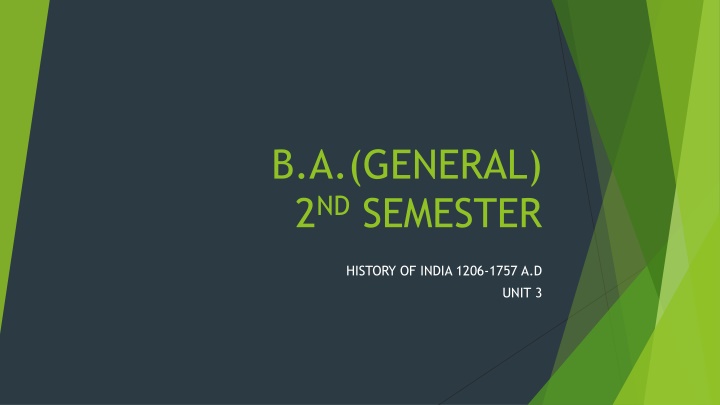Akbar's Consolidation of Mughal Rule and Administrative Reforms in India (1206-1757)
Akbar, following Humayun's death, defeated Hemu and established Mughal rule. His reign marked significant administrative and revenue reforms, including Hindu participation and religious tolerance. Akbar's policies led to the expansion and consolidation of the Mughal Empire across northern and central India, fostering cooperation with Hindu rulers through a balance of conciliation and conquest.
Download Presentation

Please find below an Image/Link to download the presentation.
The content on the website is provided AS IS for your information and personal use only. It may not be sold, licensed, or shared on other websites without obtaining consent from the author.If you encounter any issues during the download, it is possible that the publisher has removed the file from their server.
You are allowed to download the files provided on this website for personal or commercial use, subject to the condition that they are used lawfully. All files are the property of their respective owners.
The content on the website is provided AS IS for your information and personal use only. It may not be sold, licensed, or shared on other websites without obtaining consent from the author.
E N D
Presentation Transcript
B.A.(GENERAL) 2NDSEMESTER HISTORY OF INDIA 1206-1757 A.D UNIT 3
CONSOLIDATION OF MUGHAL RULE AND AKBAR CONQUEST, ADMINISTRATIVE AND REVENUE REFORMS Within a few months of Hum y n s death, his governors lost several important cities and regions, including Delhi itself, to Hemu, a Hindu minister who had claimed the throne for himself. Hum y n s son Akbar (reigned 1556 1605), under the guidance of the regent Bayram Khan, defeated Hemu at the Second Battle of Panipat (1556), which commanded the route to Delhi, and thereby turned the tide in Hindustan to the Mughal dynasty s favour. Although Akbar inherited an empire in shambles, he proved an extremely capable ruler. His expansion and absorption of vast territories established an empire across northern and parts of central India; at his death in 1605 the empire extended from Afghanistan to the Bay of Bengal and southward to what is now Gujarat state and the northern Deccan region (peninsular India). The political, administrative, and military structures that he created to govern the empire were the chief factor behind its continued survival for another century and a half.
ADMINISTRATIVE AND REVENUE REFORMS One of the notable features of Akbar s government was the extent of Hindu, and particularly Rajput, participation. Rajput princes attained the highest ranks, as generals and as provincial governors, in the Mughal service. Discrimination against non-Muslims was reduced by abolishing the taxation of pilgrims and the tax payable by non-Muslims (jizyah) in lieu of military service. Yet Akbar was far more successful than any previous Muslim ruler in winning the cooperation of Hindus at all levels in his administration. The further expansion of his territories gave them fresh opportunities. The incorporation of the zealously independent Hindu Rajputs inhabiting the rugged hilly Rajputana region came about through a policy of conciliation and conquest. When in 1562 Raja Bihari Mal of Amber (now Jaipur), threatened by a succession dispute, offered Akbar his daughter in marriage, Akbar accepted the offer. The raja acknowledged Akbar s suzerainty, and his sons prospered in Akbar s service. Akbar followed the same feudal policy toward the other Rajput chiefs. They were allowed to hold their ancestral territories, provided that they acknowledged Akbar as emperor, paid tribute, supplied troops when required, and concluded a marriage alliance with him. The emperor s service was also opened to them and their sons, which offered financial rewards as well as honour. However, Akbar showed no mercy to those who refused to acknowledge his supremacy; after protracted fighting in Mewar, Akbar captured the historic fortress of Chitor (now Chittaurgarh) in 1568 and massacred its inhabitants.
ADMINISTRATIVE AND REVENUE REFORMS Meanwhile, Akbar needed a way to maintain his status as a Muslim ruler while eliciting active support from his now predominantly non-Muslim subjects. In addition to annulling the jizyah, he abolished the practice of forcibly converting prisoners of war to Islam and encouraged Hindus as his principal confidants and policy makers. To legitimize his nonsectarian policies, he issued in 1579 a public edict (ma ar) declaring his right to be the supreme arbiter in Muslim religious matters above the body of Muslim religious scholars and jurists, whom Akbar had come to consider as shallow. He had by then also undertaken a number of stern measures to reform the administration of religious grants, which were now available to learned and pious men of all religions, including Hindu pandits, Jain and Christian missionaries, and Parsi priests. The emperor created a new order commonly called the D n-e Il h ( Divine Faith ), which was modeled on the Muslim mystical Sufi brotherhood but was devised with the object of forging the diverse groups in the service of the state into one cohesive political community. Other notable features of Akbar s government included the streamlining of both military and civil administration. He consolidated military ranks into a standard system under his authority, and regular checks on rank holders (man abd rs) ensured a reasonable correlation between their obligations and their income. He also seems to have instituted more efficient revenue assessment and collection in an effort to safeguard the peasants from excessive demands and the state from loss of money. Toward the end of his reign, Akbar embarked on a fresh round of conquests. The Kashmir region was subjugated in 1586, Sindh in 1591, and Kandah r (Afghanistan) in 1595. Mughal troops now moved south of the Vindhya Range into the Deccan. By 1601 Khandesh, Berar, and part of Ahmadnagar had been added to Akbar s empire. His last years were troubled by the rebellious behaviour of his son Prince Sal m (later the emperor Jah ng r), who was eager for power.
REFERENCES Akbar: Conquest and consolidation of the Empire: Part II SELF STUDY HISTORYselfstudyhistory.com www.britannica.com























